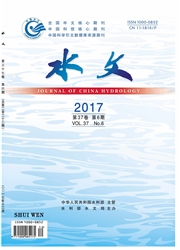

 中文摘要:
中文摘要:
数字高程模型(Digital Elevation Model,简称DEM)是地形表面形态属性的数字化表达,被广泛应用于流域水文模拟中河网水系的提取。从DEM直接提取的河网水系及相关的流域地理空间信息.是分布式水文模拟的地理信息平台。由于DEM中洼地和平坦区的存在会影响水流方向的确定和数字河网的正确提取,因此在河网自动提取过程中必须首先对DEM数据进行预处理。本文对国内外各种DEM预处理方法进行了归纳总结,将DEM数据预处理方法分为两大类:分步处理法.以及一体化处理法。分步处理法按处理对象又可分为洼地处理方法和平坦区处理方法两部分:而一体化处理法则采用迭代算法同时对洼地和平地进行处理。
 英文摘要:
英文摘要:
Digital elevation models (DEMs)can be considered as a digital representation of the topographic landscape properties. DEMs are commonly used in watershed hydrological simulation for delineating drainage networks. The drainage network and some related watershed geospatial information automated extracted from DEM is one of the fundamental geographical information platforms of distributed hydrological simulations. However, depressions and flat areas existing in the DEM will pose problems during creating an accurate representation of flow direction, therefore hampering the extraction of a continuous drainage network. These depressions and flat areas must be processed prior to using DEM for delineating the stream network. A variety of techniques has been proposed at home and abroad to preprocess the depressions and flat areas of raster DEM before drainage network extraction and analysis. According to their implicit assumptions, the preprocessing methods have been classified into two broad groups: one is the twostage approach which treats depressions and fiat areas separately, and the other is the integrated approach which solves depressions and fiat areas simultaneously by using an iterative algorithm.
 同期刊论文项目
同期刊论文项目
 同项目期刊论文
同项目期刊论文
 Statistical downscaling of daily mean temperature, pan evaporation and precipitation for climate cha
Statistical downscaling of daily mean temperature, pan evaporation and precipitation for climate cha 期刊信息
期刊信息
